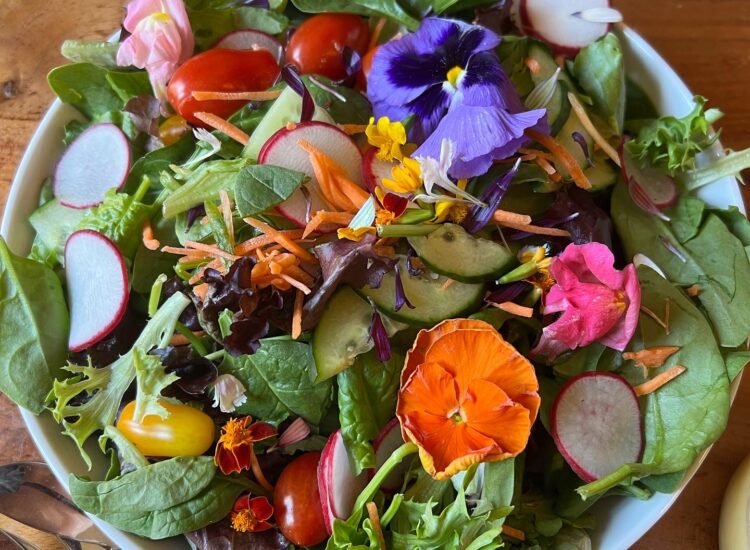My experience of creole cooking has mostly limited to listening to NPR food programs and day dreaming of trips to bayou country, so I was very pleased to be invited to a cookery demonstration by Chef Henry Butcher Senior owner of the Creole Kitchen (1052 Mount Vernon Avenue, Columbus). The demonstration was entitled ‘an evening with crawfish’ and was held in the North Market dispatch kitchen as part of their Columbus’ culinary all stars series.
Chef Butcher was a genial host, very happy to be interrupted with questions and to engage in discussions of the most suitable ingredient or method. Originally from Louisiana, the young Henry learned to cook from his grandmother who kept him tied to her apron strings and put him to work washing pots and dishes. He went to the American Chef Association straight from high school and worked his way through their two year program and then up through the ranks including a stint as a saucier where he became am expert on stocks. He worked for many years for the Hyatt hotel chain and worked all over the United States. He has been in the restaurant/hotel business for over 40 years and as you can imagine, is full of anecdotes.
Unfortunately hurricane Gustav had put a spanner in the works (I guess I should say wrench) and Chef Butcher was unable to get the delivery of fresh crawfish that he was planning to use for the demonstration. His crawfish were sitting on a runway in Atlanta, so if anyone is able to get to the Creole Kitchen this weekend there will probably be lots of crawfish on the specials board! Talking about hurricanes and their impact on the Gulf coast, Chef Butcher said that he thinks that one positive impact of Katrina is an increase in creole cooking across the country spreading with the migration of former Louisiana residents.
Crawfish (also known as crayfish) are small freshwater crustaceans like tiny lobsters (I was reminded of the Balmain bugs I had in Sydney on my birthday). Almost all of the crawfish harvested in the United States come from Louisiana, but they are now (like so many industries) competing with lower priced Chinese imports. Crawfish are commonly boiled with spices. Ideally you want to buy them live and season them to your own taste but the Chinese imports are already cooked and pre-spiced. In Louisiana they like their crawfish really spicy, it seems as an excuse to drink more beer.
The first dish Chef Butcher made was a crawfish with mesclun greens and a creamy balsamic dressing.

Crawfish salad
The dressing was made with mayonaise and balsamic vinegar whisked together and Chef Butcher suggested that you could also substitute plain yoghurt. He commented that he likes the apple tones of balsamic vinegar and often uses it alone as a marinade for chicken.
Dish number two was probably my highlight. A grilled crawfish cake made with crawfish tailmeat, green pepper, onion, celery, old bay seasoning, bread crumbs, mayonnaise. Green pepper, onion and celery are said to be ‘the holy trinity’ of creole cuisine and were used in almost every recipe. The ingredients are mixed together in a food processor and then pressed into patties. Chef Butcher said that the binding (breadcrumbs or alternatively rice) is very important to stop the cakes falling apart on the grill. The cake was extremely tender and very tasty and I could easily have eaten quite a few.
I think of remoulade as being a French or Danish sauce, but apparently it is the most popular accompaniment in Louisiana and is the tartar sauce of the region. Chef Butcher made his from mayonnaise, the holy trinity (celery, onion and green pepper), fresh parsley, horseradish, lemon zest, creole mustard, ketchup, worcestershire sauce, white vinegar, garlic and salt. Creole mustard is a pungent, dark brown wholegrain mustard. The remoulade was tasty, but a little over powering. It would be great with fish and chips, but I thought the crawfish cakes were great alone.
The last dish featured is one of the most famous creole dishes, crawfish étouffée. Chef Butcher told us that there are two secrets to making excellent étouffée and gumbo: the stock and the roux. The roux is different to the english version I am used to for white sauces. It is made with vegetable oil and flour (ideally in an iron skillet) and is cooked slowly over a low heat until it is a dark reddish brown.
The secret with the stock is to keep reducing it; Reduce, reduce reduce, said the Chef. This enhances the flavor and, creole cooking, said Chef Butcher is all about flavor. His favorite stock is a combination of chicken and shrimp infused together and simmered for as long as possible. It shouldn’t boil or it will go cloudy. If you put it in the fridge overnight it should gel [BLOOPER: at first I thought he said that if you put it in the fridge that you should be in jail- but then I realized he said that it should GEL. Obviously a preferable option]. After it has sufficiently reduced Chef Butcher uses a chinois to strain his bouillon.
The other ingredients of the étouffée were crawfish, the holy trinity, tomato puree and some of Chef Butcher’s special creole seasoning mix which he calls his ‘mojo’ and which is available at the restaurant.
It was a great introduction to creole cooking. I hope to make it to the restaurant for more of those crawfish cakes, or to try the chicken and gator gumbo, ‘gator tastes like chicken but it’s a lot more chewy’ or even for breakfast which I gather is also worth the trip. And, who knows, maybe one day I’ll make it down to bayou country, but not in hurricane season.







